![]()
![]()
![]()
Use LEFT and RIGHT arrow keys to navigate between flashcards;
Use UP and DOWN arrow keys to flip the card;
H to show hint;
A reads text to speech;
93 Cards in this Set
- Front
- Back
|
Kingdom Animalia
|
yeeehaaaa
|
|
|
Nutritional mode of animals
|
- animals are heterotrophs that ingest their food
|
|
|
Animal cell structure
|
- multicellular eukaryotes
- cells lack cell walls - Their bodies are held together by structural proteins such as collagen - nervous tissue and muscle tissue are unique to animals |
|
|
What is collagen?
|
- structural protein
|
|
|
What is unique to animals?
|
- nervous tissue
- muscle tissue - also called as true tissue |
|
|
How do animals reproduce?
|
- sexually
- diploid stage usually dominating the life cycle |
|
|
Animal reproduction
|
- after a sperm fertilises an egg, the zygote undersgoes rapid cell division called CLEAVAGE
- cleavage leads to formation of blastula - the blastula undergoes gastrulation, forming a gastrula with different layers of embryonic tissues |
|
|
animal fertilization
|

|
|
|
Many animals have at least one...
|
larval stage
|
|
|
Larva
|
sexually immature and morphologically distinct from the adult ( looks different)
|
|
|
A larva eventually undergoes...
|
metamorphosis
|
|
|
All animals, and only animals have...
|
Hox genes
|
|
|
Hox genes
|
Genes that regulate the development of body form
|
|
|
The history of animals spans more than...
|
half a billion years
|
|
|
Choanoflagellates
|
protists that are the closest living relatives of animals
|
|
|
Animals can be characterized and sometimes zoologists categorize animals by....
|
body plan
|
|
|
A grade
|
- a group whose members share key biological features
- a grade is not necessarily a clade or monophyletic group |
|
|
Animals can be categorized according to the....
|
symmetry of their bodies or lack of it
|
|
|
Two types of symmetry
|
- Radial symmetry
- bilateral symmetry |
|
|
Bilateral symmetry
|
Two sided symmetry
|
|
|
Bilaterally symmetrical animals have
|
- a dorsal (top) and ventral (bottom) side
- right and left side - Anterior (head) and posterior (tail) ends - Cephalization, the development of a head |
|
|
Cephalization
|
the development of a head
|
|
|
Radial and bilateral symmetry
|
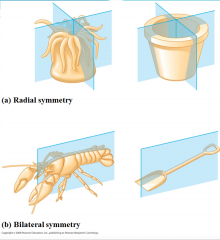
|
|
|
During development, three germ layers give rise to the tissues and organs of the animal embryo
|
- ectoderm
- endoderm - mesoderm ( in triploblastic animals) |
|
|
Ectoderm
|
Germ layer covering the embryo's surface ( outer layer)
|
|
|
Endoderm
|
the innermost germ layer and lines the developing digestive tube, called the archenteron
|
|
|
Diploblastic animals
|
have ectoderm and endoderm
|
|
|
Triploblastic animals
|
- aside from having endoderm and ectoderm, they also have an interventing mesoderm layer
- these includes all bilaterians, except platyhelminthes |
|
|
Most triploblastic animals posses a
|
body cavity
|
|
|
A true body cavity is called a?
|
Coelom, and is derived from mesoderm
|
|
|
What are animals that possess a true coelom called?
|
Coelomates
|
|
|
Coelomates
|
The tissue lining coelom and suspending the internal organs, derived from the mesoderm
|
|
|
Pseudocoelom
|
a body cavity derived from the mesoderm and endoderm
|
|
|
Triploblastic animals that posses a pseudocoelom are called?
|
Pseudocoelomate
|
|
|
Triploblastic animals that lack a body cavity are called?
|
Acoelomates
|
|
|
Two types of development
|
- Protostome development
- Deuterostome development |
|
|
In protostome development, the cleavage is?
|
spiral and determinate
|
|
|
In deuterostome development, the cleavage is?
|
Radial and indeterminate
|
|
|
Inderterminate cleavage
|
- each cell in early stages of cleavage retains teh capacity to develop into a complete embryo
|
|
|
indeterminate cleavage makes possible....
|
- identical twins
- embryonic stem cells |
|
|
How does the coelom develop in a protostome development?
|
By the splitting of solid masses of mesoderm
|
|
|
How does the coelom develop in deuterostome development?
|
the mesoderm buds from the wall of the archenteron to form the coelom.
|
|
|
in protostome development, the blastopore becomes the?
|
Mouth
|
|
|
In deuterostome development, the blastopore becomes the?
|
Anus
|
|
|
PICTURE TIME
|
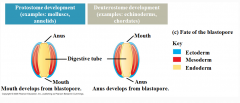
|
|
|
Animal phylogeny
|
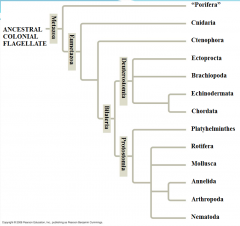
|
|
|
All animals share a?
|
common ancestor
|
|
|
What is the clade of animals with true tissue? (nerve and muscle tissue)
|
Eumetazoa
|
|
|
Most animals belong to the clade?
|
Bilateria
|
|
|
Chordates and some other phya belong to the clade?
|
Deuterostomia
|
|
|
Sponges belong to the phylas..
|
- Calcarea
- Silicea |
|
|
Sponges are?
|
- sedementary animals\
- live in fresh and marine waters - they lack true organs ( muscle and nerve tissue) |
|
|
Sponge body parts
|
- osculum ( opening/ where water exit)
- choanocyte ( generates water current) - spongocoel ( opening/ cavity where water passes through) - mesohyl ( noncellular layer between two cell layers) - amoebocytes ( found in mesohyl; plays role in digestion and sttructure) |
|
|
How do sponges feed?
|
- they are suspension feeders and captures food particles that are suspended in the water that passes through their body
|
|
|
Choanocytes
|
flagellated collar cells that generate water current through the sponge and ingest suspended food
|
|
|
Water is drawn into a cavity called__1__ and passes through the ___2___.
|
1. spongocoel
2. osculum |
|
|
Amoebocytes
|
- found in the mesohyl
- plays a role in digestion and structure |
|
|
Sponge reproduction
|
- sponges are hermaphrodites ( functions as both male and female
|
|
|
Sponge diagram
|
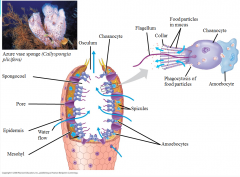
|
|
|
Phylum Cnidaria
|
Ancient phylum of eumetazoans
|
|
|
Cnidarians are....
|
- both sessile(polyp) (non-motile) and motile (medusa)
- diploblastic, radial body plan - Body plan is a sac with a central digestive compartment called the GASTROVASCULAR CAVITY - single opening functions as mouth and anus |
|
|
Cnidarians have two variations on the body plan
|
- sessile polyp
- motile medusa |
|
|
How do Cnidarians feed?
|
- they are carnivores
- use tentacles to capture prey |
|
|
The cnidarians' tentacles are armed with....
|
- cnidocytes, which functions in defense and capture prey
- withing the cnidocytes, there are NEMATOCYSTS, specialized organelles that efect stinging thread |
|
|
Phyum Platyhelminthes habitat
|
- marine
- freshwater - damp terrestrial habitats |
|
|
Although flatworms undergo triploblastic development. they are?
|
- acoelomates
- they have a gastrovascular cavity |
|
|
Examples of platyhelminthes
|
-flat worm
- tape worms |
|
|
Planarians have a.;..
|
light sensitive eyespot and centralized nerve nets
|
|
|
Planarian's nervous system vs cnidarians
|
- more complex and centralized
|
|
|
Platyhelminthes reproduction
|
- they are hermaphrodites and can reproduce sexually or asexually through fission
|
|
|
Phylum Rotifera
|
- tiny animals that inhabit freshwater, ocean, and damp soil
- smaller than many protist |
|
|
Alimentary canal
|
- present in Rotifers
- digestive tube with separate mouth and anus that lies within a fluid-filled pseudocoelom |
|
|
Rotifers reproduction
|
- reproduce by the process called parthenogenesis
- females produce offsprings from unfertilized eggs - some species are unusual that they lack males entirely |
|
|
Phylum Mollusca
|
- includes snails and slugs, oysters and clams, octopi and squids
- lives in marine. freshwater, and some are terrestrial - soft bodied animals, but most are protected by ahard shell |
|
|
All molluscs have a similar body plan with
|
- muscular foot
- Visceral mass - Mantle |
|
|
How do molluscs feed?
|
they feed using a rasplike radula
|
|
|
Mollusc body plan
|
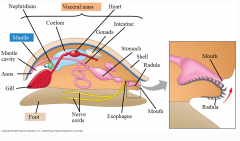
|
|
|
Molluscs reproduction
|
- have separate sexes with gonads located in the visceral mass
- life cycle includes a ciliated larval stage called TROCHOPORE |
|
|
Pylum Annelida
|
- have bodies composed of a series of fused rings
|
|
|
Phylum annelida is divided into three classes
|
- Oligochaeta (earthworms and friends)
- Polychaeta (polychaetes) - Hirundinea (leeches) |
|
|
Class Oligochaeta
|
- includes earthworms and friends ( variety of aquatic species)
- Earthworms eat through soil, extracting nutrients as the soil moves through the alimentary canal - earthworms are hermaphrodites but cross fertilize |
|
|
Polychaetes
|
- have paddle-like parapodia that works as gills and aid in locomotion
|
|
|
Hirundinea (Leeches)
|
- blood sucking parasites
- chemical called hirudin to prevent blood from coagulating |
|
|
Phylum Nematoda
|
- round worms
-parasites - found in most aquatic habitats, in soil, moist tissues of plants, and in body fluids and tissues of animals - have an alimentary canal, but lack a circulatory system - reproduction is usually sexual, by internal fertilization |
|
|
Phylum Anthropoda
|
- two out of three known species of animals are anthropods
- found in nearly all habitats of the biosphere |
|
|
Subphyla of Phylum Arthropoda
|
- Cheliceriformes ( horseshoe crabs, spiders, scorpions,ticks and mites)
- Myriapoda ( millipedes and centipedes) - Hexapoda ( insects, springtails) - Crustacea (crabs, lobsters, crayfishes, shrimps) |
|
|
The body of an arthropod is completely covered by the
? |
cuticle, an exoskeleton made of layers of protein and chitin
|
|
|
When arthropods grow,
|
it molts (shreds it to get out of it) its exoskeleton
|
|
|
Arthropods have an?
|
Open circulatory system, in which fluid called HEMOLYMPH is circulated into the spaces surrounding the tissues and organs
|
|
|
A trilobite fossil
|
often a large deposit of oil or natural gas, etc. are found where trilobite fossils are found.
they are extinct |
|
|
Insects
|
- has more species than all other forms of life combnined
- live in almost every terrestrial habitat and fresh water - has several complex organ systems - have diversified several times following the evolution of flight and the expansion of angiosperm |
|
|
What is one key to the great success of insects?
|
- Flight
- escape from predator, find food, can find new habitat much faster than others that can't fly |
|
|
Crustaceans ( crustacea)
|
- have remained in marine and fresh water for the most part
- have branched appendages that are extensively specialized for feeding and locomotion - have separate males and females |

